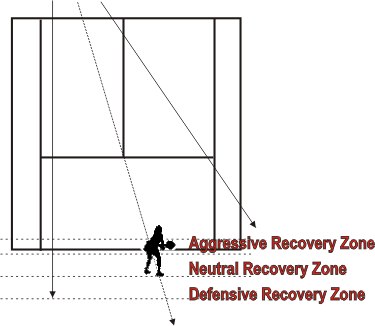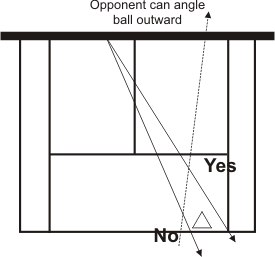|
TennisOne Lessons Dominating the Forehand Diagonal Game-Based Situation Training Wayne Elderton Situation Training is a practical application of the international coaching trend called the Game-based approach. Situation Training allows players to learn the tactics and techniques required for successful play. In my previous two articles (Baseline Re-direct and Receiving a Baseline Re-direct) we learned about the factors involved in making your down-the-line shots effective and how to receive a common down-the-line. In this article, we will explore a critical skill you can add to those that will help you command baseline exchanges.
The Story You're a 3.5-5.0 level player. In baseline rallies you are hitting solidly but, so is your opponent. It is an up and down battle with no one clearly ahead. In terms of consistency and power, you both seem evenly matched although, you seem to have a slight edge during forehand crosscourt exchanges. So how can you capitalize on this edge? Are there some strategies involved? The crosscourt exchange is one of the most common scenarios in tennis. It is seen in every match (and nearly every point). Controlling these crosscourt exchanges (what I like to call, “Dominating the Diagonals") is a critical link in successful baseline play. Watch clip #1. The crosscourt shot is the foundation of any baseline game. It allows the highest percentage of consistency (there is more court space diagonally across the court), challenges the opponent by keeping them to one side, and provides for the easiest recovery.
For too many players, tennis is just hitting a ball. That can win matches, but only to a point. Even when it comes to the many talented juniors out there a coach once lamented, “We are raising a generation of dumb hitters.” The question you need to ask yourself is, are you actually playing tennis, or just hitting balls? In other words, are you using tactics and counter tactics, do you have a clear intention of what you want to do to an opponent when you are making shots? Are you aware of what your opponent is doing to get points? It is a less effective development process to learn the strokes first and tactics later. Tactics are the reason you should be learning shots in the first place. The secret is point construction. This means stringing a sequence of purposeful shots together. Point construction maximizes your advantages by allowing you to play low risk, but high quality shots. For the situation we are looking at, here are the general tactics and the specifics involved: Dominating Baseline Tactics To dominate a crosscourt forehand baseline exchange here are 3 keys: #1: Hit a solid crosscourt “Pin”:
NOTE: Don't get fixated on any one ball characteristic (e.g. I have to keep it deep), the effect on your opponent determines success. For example, your shot can still pin if it is not as deep but has more speed and spin. Conversely, if it is not as fast, a little more depth will do the job. Watch the pros play and you will see many shots are not so crosscourt or deep but the strength of the shot (speed and spin) still pins the opponent. A good phrase is to make a, “penetrating arc.” #2: Recover well to ensure the best positioning to stay in the rally:
Figure 1: After you hit a strong crosscourt “Pin”: Aggressive recovery After you hit a neutral crosscourt “Pin”: Neutral recovery After you hit a weak crosscourt “Pin”: Defensive recovery Watch Clip # 2 (above) and see the various positions demonstrated by Andre Agassi (near side). This isn't a forehand crosscourt exchange, but it illustrates the various recovery depths well. He hits a good serve and, takes an aggressive recovery position inside the baseline anticipating a weak return. He gets the weak ball which earns him an even more forward court position. However, he sees his shot is weak and then recovers to a neutral position behind the baseline. Not able to send a strong shot he must retreat even further for defense. Agassi is only ever on the line when he earns the position. Anyone who has seen him play live knows he (like all good pros) recovers appropriately for the shot. He is often well behind the line although, the misconception is that he never retreats. Here is the situation outlined on our Shot Situation chart:
#3: Maintain your most effective diagonal by Re-directing: By combining the last two articles and this one, you can have an effective tactical package. Ask yourself, “If I get into a forehand to forehand exchange, who will win most often? What about a backhand to backhand exchange?” If you will win both, just keep hitting crosscourts (don't worry about risking re-directing).
If you can win one side only, use your re-direct down-the-line to keep that one going most often. For example, if you can win in a backhand exchange but are shaky on the backhand, when your opponent gives a weaker crosscourt to your backhand, go for a low-risk re-direct down the line. This will entice them to go crosscourt to your forehand and your favorite diagonal has begun. Drilling To practice pinning, I recommend two drills. Both are slight variations of basic drills that have been around for as long as tennis has been played. Drill #1: With a ball machine, coach, or partner feeding you a neutral crosscourt ball, practice repeating your pinning crosscourt. The one downside of such a familiar drill is that players can get lazy with the important details. Make sure the following is included on every shot:
Figure 2: Direction = Crosscourt: The ball must be crosscourt enough to force the opponent into the corner. The shot cannot be so much in the middle that they are able to create any angle outwards towards the sideline.
Drill #2: Rally with a partner forehand crosscourt to forehand crosscourt. If either player receives a weaker ball, they can re-direct. The point is over after a player re-directs or someone makes an error. An error counts for nothing and the exchange begins again. If the re-direction is successful, they receive one point. If unsuccessful, they lose two points (little motivation to go for a risky shot). The goal is to have such a high quality crosscourt exchange that the opponent cannot re-direct without risk. Make sure to share with your partner if the crosscourts are difficult to receive or easy. Next installment: “Dominating the Backhand Diagonal.” Your comments are welcome. Let us know what you think about Wayne Elderton's article by emailing us here at TennisOne.
|
||||||||||||||||||||||||||||||||




 Wayne Elderton
Wayne Elderton